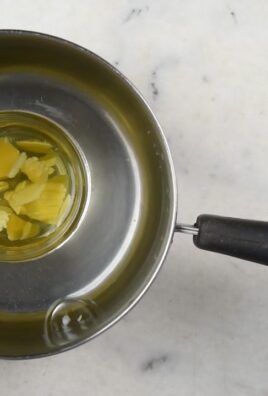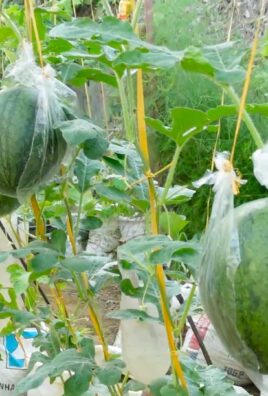Growing grapes in pots might seem like a challenge reserved for seasoned vineyard owners, but I’m here to tell you it’s totally achievable, even if you only have a small balcony or patio! Forget acres of land; we’re bringing the vineyard to you, one pot at a time. Have you ever dreamed of plucking fresh, juicy grapes right from your own backyard (or balcony)? Imagine the satisfaction of serving homemade grape juice or adding homegrown grapes to your cheese board.
Grape cultivation has a rich history, dating back thousands of years to ancient civilizations like the Egyptians and Romans, who revered grapes for their delicious fruit and the wine they produced. Today, while large-scale vineyards dominate the market, the joy of growing your own grapes remains a deeply satisfying experience.
Why should you try this DIY trick? Well, space is often a limiting factor for many aspiring gardeners. Growing grapes in pots allows you to enjoy the beauty and bounty of grapevines without needing a sprawling garden. Plus, it gives you greater control over the growing environment, protecting your precious vines from harsh weather and pests. I’m excited to share my favorite tips and tricks to help you successfully grow grapes in pots, transforming your small space into a miniature vineyard. Let’s get started!

Growing Grapes in Pots: A Comprehensive DIY Guide
Hey there, fellow gardening enthusiasts! Ever dreamt of having your own little vineyard, but you’re short on space? Well, I’m here to tell you that growing grapes in pots is totally achievable, and I’m going to walk you through every step of the process. It’s easier than you think, and the reward of plucking your own homegrown grapes is absolutely worth it.
Choosing the Right Grape Variety
First things first, not all grape varieties are created equal when it comes to container gardening. You’ll want to select a variety that’s well-suited for smaller spaces and has a good track record of producing fruit in pots. Here are a few of my personal favorites:
* ‘Himrod’ Seedless: This is a fantastic choice for beginners. It’s a white seedless grape that’s known for its sweetness and disease resistance. Plus, it’s relatively compact, making it perfect for containers.
* ‘Reliance’ Seedless: Another excellent seedless option, ‘Reliance’ produces beautiful pink grapes with a delightful flavor. It’s also very cold-hardy, which is a bonus if you live in a colder climate.
* ‘Vanessa’ Seedless: If you’re looking for a red seedless grape, ‘Vanessa’ is a great choice. It’s known for its crisp texture and sweet-tart flavor.
* ‘Thompson’ Seedless: The classic table grape! While it can be a bit more vigorous, with proper pruning, ‘Thompson’ Seedless can thrive in a large container.
* Dwarf Grape Varieties: Keep an eye out for varieties specifically bred for smaller spaces. These are often labeled as “patio” or “dwarf” grapes.
Important Note: Before you commit to a variety, check its hardiness zone to ensure it’s suitable for your local climate.
Gathering Your Supplies
Okay, now that we’ve got our grape variety sorted, let’s gather everything we need to get started. Here’s a checklist:
* A Large Container: This is crucial! You’ll need a pot that’s at least 24 inches in diameter and 24 inches deep. The bigger, the better, as it will give your grape vine plenty of room to grow. Make sure it has drainage holes!
* High-Quality Potting Mix: Don’t skimp on this! Use a well-draining potting mix specifically formulated for containers. Avoid using garden soil, as it can become compacted and doesn’t drain well.
* Grape Vine: Purchase a healthy, one-year-old grape vine from a reputable nursery. Look for a vine with a strong root system and a few healthy canes.
* Trellis or Support Structure: Grapes are vines, so they need something to climb on. A trellis, obelisk, or even a sturdy tomato cage will work.
* Pruning Shears: Sharp pruning shears are essential for maintaining your grape vine.
* Fertilizer: Use a balanced fertilizer specifically formulated for fruit-bearing plants.
* Watering Can or Hose: For regular watering.
* Gloves: To protect your hands.
Planting Your Grape Vine
Alright, let’s get our hands dirty! Here’s how to plant your grape vine in its new home:
1. Prepare the Container: Place a layer of gravel or broken pottery at the bottom of the container to improve drainage. This will help prevent the roots from sitting in water.
2. Fill with Potting Mix: Fill the container about two-thirds full with your high-quality potting mix.
3. Position the Vine: Carefully remove the grape vine from its nursery pot and gently loosen the roots. Place the vine in the center of the container, making sure the top of the root ball is level with the soil surface.
4. Fill with More Potting Mix: Fill in the remaining space around the root ball with potting mix, gently firming the soil as you go.
5. Water Thoroughly: Water the newly planted grape vine thoroughly until water drains out of the bottom of the container. This will help settle the soil and ensure the roots are well-hydrated.
6. Add Trellis: Install your trellis or support structure behind the grape vine. Gently guide the main cane of the vine towards the trellis and loosely tie it in place with soft twine or plant ties.
Caring for Your Potted Grape Vine
Now that your grape vine is planted, it’s time to provide it with the care it needs to thrive. Here’s what you need to do:
* Watering: Grape vines need consistent moisture, especially during the growing season. Water deeply whenever the top inch of soil feels dry to the touch. Avoid overwatering, as this can lead to root rot.
* Fertilizing: Feed your grape vine with a balanced fertilizer in the spring, just as new growth begins to emerge. Follow the instructions on the fertilizer package carefully. You can also apply a second dose of fertilizer in mid-summer.
* Sunlight: Grape vines need at least 6-8 hours of direct sunlight per day to produce fruit. Choose a sunny location for your container.
* Pruning: Pruning is essential for maintaining the shape and productivity of your grape vine. I usually prune in late winter or early spring, before new growth begins. Remove any dead, damaged, or crossing canes. You’ll also want to shorten the remaining canes to encourage fruit production.
* Pest and Disease Control: Keep an eye out for common grape vine pests and diseases, such as aphids, spider mites, and powdery mildew. Treat any infestations or infections promptly with appropriate organic or chemical controls.
* Winter Protection: If you live in a cold climate, you’ll need to protect your potted grape vine from freezing temperatures. You can either move the container to a sheltered location, such as a garage or shed, or wrap the container with burlap or insulation to protect the roots.
Pruning Your Potted Grape Vine: A Detailed Guide
Pruning can seem intimidating, but it’s really not that difficult once you understand the basics. Here’s a step-by-step guide to pruning your potted grape vine:
1. Timing is Key: The best time to prune grape vines is in late winter or early spring, before new growth begins. This is when the vine is dormant and less susceptible to stress.
2. Remove Dead, Damaged, or Diseased Wood: Start by removing any canes that are dead, damaged, or diseased. These canes will not produce fruit and can harbor pests and diseases.
3. Identify the Main Cane(s): The main cane(s) are the thickest, strongest canes that emerge from the base of the plant. These canes will form the framework of your grape vine.
4. Choose Your Training System: There are several different training systems you can use for grape vines, but the most common for container gardening is the cordon system. In this system, you train the main cane(s) horizontally along the trellis.
5. Select Fruiting Spurs: Fruiting spurs are short, lateral shoots that emerge from the main cane(s). These spurs are where the grapes will be produced. Select spurs that are healthy and well-spaced along the main cane(s).
6. Prune the Spurs: Prune each fruiting spur back to 2-3 buds. This will encourage the spur to produce strong, healthy shoots that will bear fruit.
7. Remove Excess Canes: Remove any canes that are not part of the main cane(s) or fruiting spurs. These canes will only compete with the fruiting canes for resources.
8. Clean Up: After pruning, clean up any debris around the base of the plant. This will help prevent the spread of pests and diseases.
Pro Tip: Don’t be afraid to prune your grape vine aggressively. Grape vines are very resilient and can tolerate heavy pruning. In fact, pruning is essential for maintaining the health and productivity of your vine.
Harvesting Your Grapes
The moment you’ve been waiting for! Harvesting your own homegrown grapes is incredibly satisfying. Here’s how to know when your grapes are ready to pick:
* Check the Color: The color of the grapes should be uniform and characteristic of the variety. For example, green grapes should be a translucent green, red grapes should be a deep red, and black grapes should be a deep purple or black.
* Taste Test: The best way to determine if your grapes are ripe is to taste them. They should be sweet and juicy, with a pleasant flavor.
* Check the Seeds: If your grape variety has seeds, the seeds should be brown and easily separated from the pulp.
* Harvest Carefully: Use sharp pruning shears to cut the grape clusters from the vine. Handle the grapes gently to avoid bruising them.
Enjoy Your Harvest! Once you’ve harvested your grapes, you can enjoy them fresh

Conclusion
So, there you have it! Growing grapes in pots might seem daunting at first, but with a little planning and the right approach, you can absolutely enjoy the fruits (literally!) of your labor, even without a sprawling vineyard. This DIY method opens up the possibility of cultivating your own delicious grapes, regardless of whether you have a small balcony, a patio, or simply want the flexibility of moving your vines around.
Why is this a must-try? Because it puts the power of fresh, homegrown grapes directly into your hands. Imagine plucking sun-ripened grapes straight from your own vine, knowing exactly where they came from and how they were grown. Think of the delicious homemade jams, jellies, or even the satisfaction of crafting your own small batch of wine. Beyond the culinary delights, growing grapes in pots is a rewarding experience that connects you with nature and adds a touch of rustic charm to your outdoor space.
But don’t stop there! Experiment with different grape varieties to find your perfect match. Try a hardy Concord for classic grape juice, a sweet Thompson Seedless for snacking, or a robust Cabernet Sauvignon if you’re feeling ambitious about winemaking. Consider adding companion plants to your pots, like basil or rosemary, to deter pests and enhance the overall health of your vines. You can also play around with different trellis designs to create a visually stunning focal point in your garden.
We’ve covered the essentials, from choosing the right pot and soil to providing adequate sunlight and support. Now it’s your turn to get your hands dirty and embark on this exciting gardening adventure. Don’t be afraid to make mistakes – that’s how we learn! The key is to be patient, observant, and willing to adapt your approach as needed.
We are confident that you can successfully grow grapes in pots. The satisfaction of harvesting your own grapes is well worth the effort.
So, what are you waiting for? Grab a pot, select your favorite grape variety, and get started today! We’re eager to hear about your experiences. Share your photos, tips, and challenges in the comments below. Let’s create a community of grape-growing enthusiasts and inspire others to discover the joy of homegrown goodness. Happy growing!
Frequently Asked Questions (FAQs)
What is the best type of grape to grow in a pot?
The best type of grape to grow in a pot depends on your climate, personal preferences, and intended use for the grapes. Generally, grape varieties that are naturally smaller and more compact are better suited for container gardening. Some popular choices include:
* **’Himrod’ Seedless:** A white seedless grape known for its sweetness and disease resistance. It’s a good choice for eating fresh.
* **’Reliance’ Seedless:** A red seedless grape that is very cold-hardy, making it suitable for colder climates.
* **’Vanessa’ Seedless:** Another red seedless variety with excellent flavor and good disease resistance.
* **’Thompson Seedless’:** A classic green seedless grape, widely available and popular for eating and making raisins.
* **’Concord’:** A blue-purple grape with a distinctive flavor, often used for juice and jelly. Choose a dwarf or compact variety if possible.
* **’Pinot Noir’ or ‘Chardonnay’:** If you’re interested in winemaking, these varieties can be grown in pots, but they may require more attention and specific growing conditions.
Consider your local climate and choose a variety that is known to thrive in your region. Also, check with your local nursery or extension office for recommendations on grape varieties that are well-suited for container gardening in your area.
How big of a pot do I need for growing grapes?
A general rule of thumb is to start with a pot that is at least 15-20 gallons in size. This will provide enough room for the roots to develop and support the growth of the vine. As the vine matures, you may need to transplant it into a larger pot, potentially up to 25-30 gallons or more. The bigger the pot, the more room the roots have to grow, and the more stable the vine will be.
Make sure the pot has adequate drainage holes to prevent waterlogging, which can lead to root rot. You can also use a pot made of breathable material, such as terracotta, to improve drainage and aeration.
How often should I water my potted grape vine?
Watering frequency will depend on several factors, including the size of the pot, the type of soil, the climate, and the stage of growth of the vine. In general, you should water your potted grape vine when the top inch or two of soil feels dry to the touch.
During the growing season (spring and summer), you may need to water more frequently, especially during hot, dry weather. Check the soil moisture regularly and water deeply, ensuring that the water drains out of the bottom of the pot. Avoid overwatering, as this can lead to root rot.
In the fall and winter, when the vine is dormant, you can reduce watering frequency. Water only when the soil is dry to the touch.
What kind of fertilizer should I use for my grape vine?
Use a balanced fertilizer specifically formulated for fruit trees or grape vines. A 10-10-10 or 12-12-12 fertilizer is a good starting point. Apply the fertilizer according to the instructions on the package, typically in the spring and early summer. Avoid fertilizing too late in the season, as this can encourage new growth that may not harden off before winter.
You can also supplement with organic fertilizers, such as compost or aged manure, to improve soil fertility and provide essential nutrients. Be careful not to over-fertilize, as this can damage the vine.
How do I prune my potted grape vine?
Pruning is essential for maintaining the health and productivity of your potted grape vine. The best time to prune is in late winter or early spring, before new growth begins.
Remove any dead, damaged, or diseased wood. Also, prune to shape the vine and encourage fruit production. Grape vines produce fruit on new growth, so you’ll want to prune to encourage the development of new shoots.
There are different pruning methods for different grape varieties, so it’s important to research the specific needs of your grape vine. In general, you’ll want to remove most of the previous year’s growth, leaving only a few buds on each cane.
How do I protect my potted grape vine from pests and diseases?
Regularly inspect your grape vine for signs of pests or diseases. Common pests include aphids, spider mites, and Japanese beetles. Diseases include powdery mildew, downy mildew, and black rot.
If you detect pests or diseases, take action promptly to prevent them from spreading. You can use organic pest control methods, such as insecticidal soap or neem oil, to control pests. For diseases, you can use fungicides specifically formulated for grape vines.
Good air circulation and proper watering can also help prevent pests and diseases. Avoid overcrowding the vine and water at the base of the plant to avoid wetting the foliage.
Can I move my potted grape vine indoors for the winter?
If you live in a climate with harsh winters, you may need to protect your potted grape vine from freezing temperatures. One option is to move the pot indoors to a cool, dark location, such as a garage or basement.
Before moving the vine indoors, prune it back and remove any remaining leaves. Water sparingly during the winter months, only when the soil is dry to the touch.
In the spring, gradually acclimate the vine to outdoor conditions before placing it back in its permanent location.
How long does it take for a grape vine to produce fruit?
It typically takes 2-3 years for a grape vine to start producing fruit. The first year, the vine will focus on establishing its root system. The second year, it will start to produce more foliage. By the third year, you should start to see some fruit production.
Be patient and continue to provide proper care for your vine. With time and attention, you’ll be rewarded with delicious, homegrown grapes.





Leave a Comment